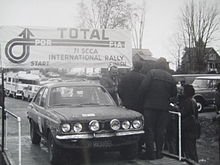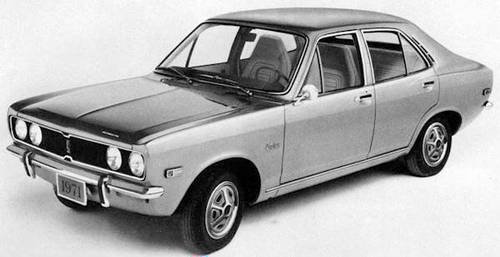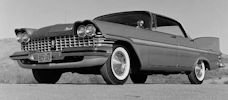Plymouth Cricket (1971–1973)
| |
Make: | Plymouth |
Production period: | 1971 to 1973 |
Class : | Motor car |
Body versions : | Limousine , station wagon |
Engines: | Gasoline 1.5 liters (52 kW) |
The Plymouth Cricket was a 1971 to 1973 by the US automakers Plymouth (Chrysler) small cars . It was a US-approved Hillman Avenger .
As small cars imported in the USA became more and more popular, the major US automakers entered the market for model year 1971. Ford and GMC brought specially developed models, the Pinto and the Chevrolet Vega . Chrysler, however, sat on the renaming (Rebadging) of existing small cars from Japan and Great Britain . The basic model for the Plymouth Cricket came from the then part of the Chrysler Group Rootes Group .
Plymouth Cricket is built by Chrysler's British division and had been on sale for some time in Europe under another name the Avenger.The Cricket is a true subcompact car designed for straightforward economical operation. The engine is a 91.41 cubic-inch 4, rated at 69 bhp at 5200 rpm. Top speed is about 90 mph. Disc brakes are fitted up front, drums to the rear. Unitized body construction used on the Cricket is a 4-door sedan only. The intention is to provide an uncomplicated car.
The first shipment from the United Kingdom reached the United States on November 20, where it was sold as a 1971 model year. The adjustments included headrests integrated in the seats , four round lights as headlamps and the elimination of the weaker engine. Offered was a 1.5-liter four-cylinder with overhead camshaft and 70 bhp (52 kW), which optionally transferred via a manual four-speed gearbox or a three-speed automatic transmission, the force on a rigid rear axle . On the four-door hatchback sedan followed in 1972, a five-door station wagon .
The name Cricket was chosen to benefit from the success of the VW Beetle , but the cricket was anything but a success for Plymouth. The new car was plagued by a number of teething troubles and suffered from poor rust prevention. From 1972, cricket was no longer imported, with the vehicles of the 1973 model year, it was only sales of the previous year. The exact number of sold copies is unknown; In 1971/72 41,564 pieces were sold.
Cricket came too early into the US market in two ways: the model was not mature enough in 1971, and a later model launch would have allowed Chrysler to identify and fix any issues that might arise. Before 1973, small cars in the US were difficult to sell, only the 1973 oil crisis caused a rethink, but that came too late for the already set cricket.
The also belonging to Chrysler car brand Dodge offered at the same time the Dodge Colt , a renamed Mitsubishi Lancer . This cooperation proved to be much more successful, so that also Plymouth offered from 1976 a renamed Mitsubishi, the Plymouth Arrow
In North America, the Avenger was sold as the Plymouth Cricket through Plymouth dealers as a captive import. The car was essentially an example of badge engineering and Plymouth made few changes to it. Only the 4-door saloon and 5-door estate variants were ever offered, due to the 2-door Avenger being unavailable at the time. It had 9.5" front disc brakes and 8" rear drums. Brochures included a cartoon cricket.
A Chrysler Plymouth press release dated 30 June 1970 stated that the Cricket was going to be shown to the automotive press for the first time in November 1970. The first shipment of 280 Crickets from the UK arrived in the U.S. on 20 November 1970. Another press release issued on 23 February 1972 stated that the "station wagon" version was going to début in early spring of 1972.
Differences from the Avenger
The 1500 cc engine was offered on the Plymouth Cricket, the 1250 being a little underpowered for American tastes. Side parking lights were added, and front disc brakes were standardised; these were originally optional in the UK. The single carburettor / manual choke combination was standard. From 1972, the single carburettor / automatic choke combination, dual carburettors, and air conditioning were all options.
Due to American federal laws regarding headlight design, all Cricket models regardless of trim level used the round four-headlight grille of the GL and GT model Avengers.
Demise of the Cricket
The Cricket was discontinued midway through the 1973 model year, despite the gas crisis of 1973 seeing a sharp increase in demand for small cars and despite the fact that Dodge began to see real success with its similarly-sized Dodge Colt, built by Mitsubishi Motors.
The Cricket name lived on in Canada, however, as Chrysler Canada replaced the British-built Cricket with a rebadged Dodge Colt in mid-1973 model year. The Cricket's version of the Colt GT was called the Cricket Formula S. For the 1975 model year, the Plymouth Cricket was rebadged as the Plymouth Colt. Thus began Chrysler Canada's dual marketing system, selling the Colt as both a Dodge and a Plymouth. The later Plymouth Arrow was similarly sold as a Dodge Arrow.
The last British-built Crickets were exported to the U.S. in the later part of 1972, but were sold until mid-1973 as "1973" models. This was because U.S. safety and emission laws became effective based on the calendar year the car was manufactured in or imported in, as opposed to the model year. Chrysler used this loophole to continue selling what were essentially 1972 cars through 1973 as 1973 models
Length: 4115-4239 mm
Width: 1588 mm
Height: 1387-1395 mm
Wheelbase: 2500 mm
Curb weight: 864-887 kg

Plymouth Cricket, winner of the 1971 Rally
Rating
Technical
-
Chrysler Plymouth Cricket Technical details and specifications (1971-1973)
ENGINE
Type -4-stroke; O.H.V. side camshaft (high)
Cooling system - Water pump, radiator (9 lb./sq.m.), fan and thermostat
Number of cylinders - 4 (direct in block or liners
Firing order and idling speed - 1-3-4—2 (No. 1 at front); 700/750 r.p.m. (800 for Emission Control)
Bore - 3•39in. (86•1mm)
Stroke - 2•53in. (64•3mm)
Cubic capacity - 1498c.c.
Compression ratio and pressure - 9.2.:1
Brake horse-power (DIN) - 63 at 5,000 r.p.m.
Torque (DIN) - 80 74 lb.ft. at 3,000 r.p.m.TRANSMISSION
Type -Rear-wheel drive
Clutch - Borg & Beck 7.5in., diaphragm type; free movement, 3/16in. at release lever
Gearbox manual - 4 forward speeds, all synchromesh
Gearbox automatic - Borg-Warner Model 35
Gearbox ratios (manual) - 1.366 ,2.029,3.317, R3.450
Final drive gear - Hypoid bevel
Final drive ratio - 3.889:1 (35/9)
BRAKES (Dual circuit)
Front - Girling 9.5in. diam. discs
Rear - Girling 8in. diam. drums
Handbrake - Mechanical, on rear wheelsSTEERING
Type - Rack and pinionFRONT SUSPENSION
Type - Macpherson strut with anti-roll barREAR SUSPENSION
Type - Coil springs with upper diagonal) and lower (longitudinal)ELECTRICAL SYSTEM
Ignition coil - Lucas 11C12
Battery - 12v. 33, 40 or 50a.h. (at 20-hr. rate)
Battery earth - NegativeDIMENSIONS
Length overall - 13ft. 5 1/4in. (4096mm.)
Width overall - 62 1/2in. (1587mm.)
Height overall (laden) - 53 1/2 in. (1359mm.)
Weight (kerb) - 1911 1b. 17.06cwt.) (867kg)
Ground clearance (min.) - 5 1/2in. (140mm.) laden
Track
Front - 51in. (1295mm.)
Rear - 51 1/4in. (1302mm.)
Wheelbase - 98in. (2489mm.)
© Motor car History
-
Plymouth Cricket Maintenance (1971-1973)
Servicing intervals - 5,000 miles or 6 months
ENGINE
Type -4-stroke; O.H.V. side camshaft (high)
Firing order and idling speed - 1-3-4—2 (No. 1 at front); 700/750 r.p.m. (800 for Emission Control)CAPACITIES
Engine sump (pints) - 7 pints (incl. filter, pint)
Gearbox - 3 pints; auto., 11 1/4 (incl. 5 1/2 in conv.)
Differential - 1 1/2 pints
Cooling system - 13 pints (incl. heater)
Fuel tank - 9 gallons
Tyre size (standard) - 155 X 13 radial optional
Tyre pressures (lb./in.2) - 24/30*ENGINE
Type -4-stroke; O.H.V. side camshaft (high)
Cooling system - Water pump, radiator (9 lb./sq.m.), fan and thermostat
Number of cylinders - 4 (direct in block or liners
Firing order and idling speed - 1-3-4—2 (No. 1 at front); 700/750 r.p.m. (800 for Emission Control)
Bore - 3•39in. (86•1mm)
Stroke - 2•53in. (64•3mm)
Cubic capacity - 1498c.c.
Compression ratio and pressure - 9.2.:1
Brake horse-power (DIN) - 63 at 5,000 r.p.m.
Torque (DIN) - 80 74 lb.ft. at 3,000 r.p.m.Piston oversizes - 030 in. max. (with or without liners)
Piston clearance in bore - •0015/ • 0023in. all rings 5/8 from piston
Piston rings—-number - 2 compression, 1 oil
Piston rings—width - .0015/.0035in., all rings
Piston rings—groove clearance - 0015/.0035in.(from piston bottom)
Piston rings—gap (in bore) - Top, .014/.018in.; others, .010/.014in.
(in grade 'A' bore)
Oil pressure - 50/60 1b./sq.in., hotGudgeon pin diameter - 0.9378 to 0.9374in. (in 4 grades)
Gudgeon pin fit in piston - Finger push at 70°F
Crankpin diameter - (A) 1.9995/2.OOOOin.; (B) 1.9895/ 1.9900in.
Connecting rod length - 4•964 to 4•966in. (centres)
Big-end bearings - Steel shell, aluminium-tin lined (or lead-indium)
Big-end bearing clearance - .0009 to .0024in.
Big-end side clearance - .007 to .012in.
Main journal diameter - (A) 2.1245/2.1252in.; (B) 2.1145/ 2.1152in.
Main bearings undersize - Maximum, •040in.
Main bearing - 5; steel shell, aluminium-tin lined (or
lead-indium)
Main bearings clearance - .0005 to .0025in.Crankshaft end-float - .002 to .008in.
Crankshaft end-thrust on - main rear
Camshaft journal diameter - (1) 1.9345/1.9352in, (2) 1-7470/
1.7477in., (3) 1.5595/1.5602in.
Camshaft bearings - 3 ; aluminium-tin
Camshaft bearing clearance - .0013 to .0030in.
Camshaft end-float - .004 to .009in.
Camshaft drive type - Single roller chain
Valve head diameter - Inlet, 1.418/1-422in.; 1.202in.
Inlet, 0.3110/0.3115in., 0.3100in.
Valve seat angle - 45° (same face angle) - -
Valve stem/guide clearance - Inlet, .001/.0025in. exh.,.0025/
.0045in.
Valve spring rate - Fitted length, 1.505in. at 701b.
Valve working clearance -Inlet, •008in.; exh., .016in. (hot or cold) 0.100in.; closing position 220 B.T.D.C., exhaust
Valve timing - 35°-69°-69°-23°
Petrol pump - A.C. mechanical (2.75 to 4.25 lb./sq.in.)
Carburettor - Stromgberg 150CDSTRANSMISSION
Type -Rear-wheel drive
Clutch - Borg & Beck 7.5in., diaphragm type; free movement, 3/16in. at release lever
Gearbox manual - 4 forward speeds, all synchromesh
Gearbox automatic - Borg-Warner Model 35
Gearbox ratios (manual) - 1.366 ,2.029,3.317, R3.450
Driving axles - Semi-floating
Final drive gear - Hypoid bevel
Final drive ratio - 3.889:1 (35/9)
Crown wheel/pinion b'lash - .005 to .009in.
Pinion bearing pre-load - 8/15 1b. (new), 6/11 1b. (used) pull
tangential to coupling centre (with oil seal)
Diff. bearing pre-load - 4/5 1b. additional pull at pinion coupling
BRAKES (Dual circuit)
Front - Girling 9.5in. diam. discs
Rear - Girling 8in. diam. drums
Handbrake - Mechanical, on rear wheels
Linings—front (bonded) - Mintex M108GH pads
Linings—rear (riveted) - Don 202GG
Power assistance - Girling, Type 28 vac. servo (optional)STEERING
Type - Rack and pinion
Camber angle - 1±45'
Castor angle - 1±30'
King-pin inclination -11°30'±45'FRONT SUSPENSION
Type - Macpherson strut with anti-roll bar
Number of coils - 7-03-7-88
Coil diameter (external) -4.50in.
Wire diameter (mean) -
Spring length—free - 13-30 to 14-40
Spring rate - 570-630lb.REAR SUSPENSION
Type - Coil springs with upper diagonal) and
lower (longitudinal)
Number of coils -8-09 to 8-49
Coil diameter -3.517in.
Spring length— free - 11.72in.
Spring rate - 7401bELECTRICAL SYSTEM
Ignition timing—static - 6° to 8° B.T.D.C. (9-2:1 and 8-0:1)
Sparking plugs - Champion N9Y
Sparking plug gap - .025in.
Ignition coil - Lucas 11C12
Battery - 12v. 33, 40 or 50a.h. (at 20-hr. rate)
Battery earth - Negative
Alternator - Lucas C40-1, C40-L or 16ACR
Starter motor - Lucas M35J (or M35J-PE, pre-engaged)CAPACITIES
Engine sump (pints) - 7 pints (incl. filter, pint)
Gearbox - 3 pints; auto., 11 1/4 (incl. 5 1/2 in conv.)
Differential - 1 1/2 pints
Cooling system - 13 pints (incl. heater)
Fuel tank - 9 gallons
Tyre size (standard) - 155 X 13 radial optional
Tyre pressures (lb./in.2) - 24/30*Servicing intervals - 5,000 miles or 6 months
Hydraulic fluid - Castrol/Girling AmberDIMENSIONS
Length overall - 13ft. 5 1/4in. (4096mm.)
Width overall - 62 1/2in. (1587mm.)
Height overall (laden) - 53 1/2 in. (1359mm.)
Weight (kerb) - 1911 1b. 17.06cwt.) (867kg)
Ground clearance (min.) - 5 1/2in. (140mm.) laden
Track
Front - 51in. (1295mm.)
Rear - 51 1/4in. (1302mm.)
Wheelbase - 98in. (2489mm.)
Turning circle diameter - 31ft. 6in. (at wheels)
Type of construction - Integral, all steel (bolt-on front wings)
Windscreen glass - Zone toughened
TORQUE SPANNER DATA (lb.ft)
Cylinder head nuts - 60 (cold)
Big-end bearing nuts - 29/ 908.
Main bearing nuts - 52/ 909.
Flywheel bolts - 40
Clutch to flywheel bolts - 16
Crown wheel bolts 47
Differential bearing nuts 36
Road wheel nuts - 55
Steering wheel nut - 32
© Motor car History- Plymouth Cricket (1971-1973) Advanced Maintenance is available for registered users-
© Motor car History





